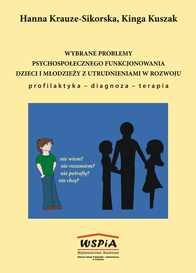Wybrane problemy psychospołecznego funkcjonowania dzieci i młodzieży z utrudnieniami w rozwoju. Profilaktyka – diagnoza – terapia, red. Hanna Krauze-Sikorska, Kinga Kuszak
This work is the result of studies, reflections, and analyses by authors who approach the issues of development and support for children with special developmental and educational needs from various perspectives, through the lens of their own experiences. It addresses a number of important topics but does not provide definitive answers. Instead, it aims to provoThis work is the result of studies, reflections, and analyses by authors who approach the issues of development and support for children with special developmental and educational needs from various perspectives, through the lens of their own experiences. It addresses a number of important topics but does not provide definitive answers. Instead, it aims to provoke reflection and encourage the search for personal strategies for working with children requiring special support. It is primarily directed at educators, teachers, caregivers, therapists, students of pedagogical, psychological, and teaching disciplines, as well as parents of children with developmental difficulties. It represents our search for an effective and cohesive system for supporting the child and their family, though it is not presented as a universal or the only correct concept. Rather, it serves as a contribution to the discussion and an attempt to highlight the multifaceted and complex nature of this issue. By presenting this work to the reader, we aim to outline directions for further inquiries and analyses.ke reflection and encourage the search for personal strategies for working with children requiring special support. It is primarily directed at educators, teachers, caregivers, therapists, students of pedagogical, psychological, and teaching disciplines, as well as parents of children with developmental difficulties. It represents our search for an effective and cohesive system for supporting the child and their family, though it is not presented as a universal or the only correct concept. Rather, it serves as a contribution to the discussion and an attempt to highlight the multifaceted and complex nature of this issue. By presenting this work to the reader, we aim to outline directions for further inquiries and analyses.

